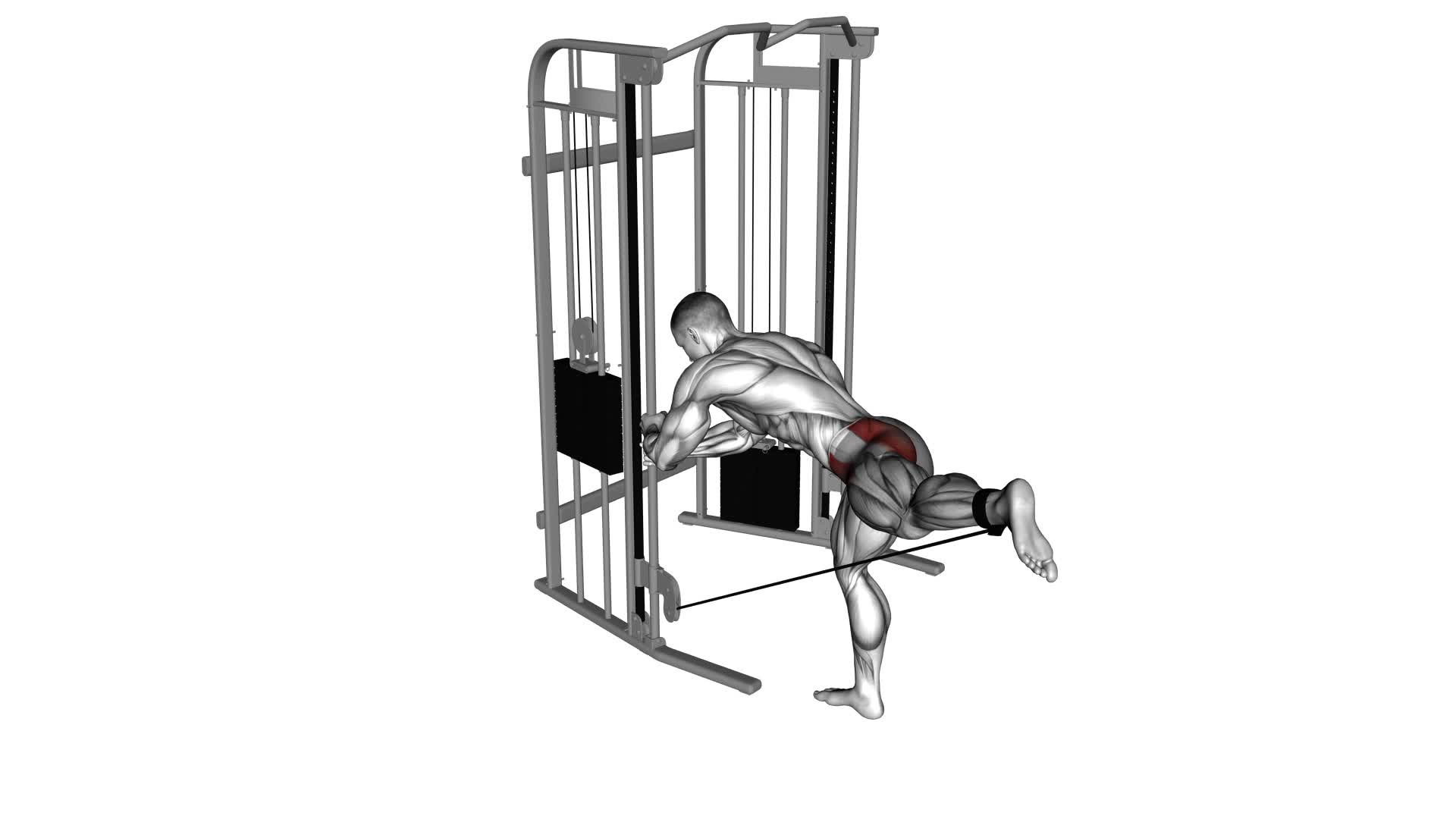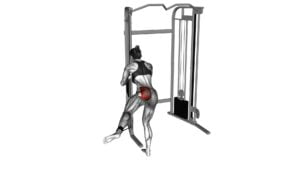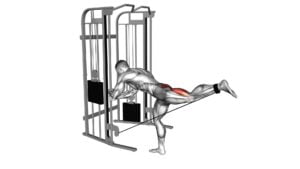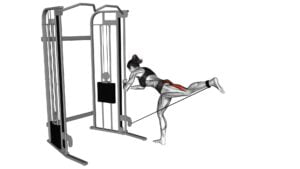Cable Donkey Diagonal Kickback (male) – Video Exercise Guide & Tips

Are you looking to add a new exercise to your workout routine?
Watch This Exercise Video
Check out the Cable Donkey Diagonal Kickback! This video exercise guide and tips will show you the proper form and technique for this challenging exercise.
Avoid common mistakes and learn variations to add more challenge.
With the Cable Donkey Diagonal Kickback, you can target your glutes and strengthen your lower body effectively.
Get ready to kick your fitness goals into high gear!
Key Takeaways
- Cable Donkey Diagonal Kickbacks target glutes, hamstrings, and core muscles.
- The exercise activates gluteus maximus, medius, and minimus.
- It provides a unique angle of resistance and engages glutes in a different way.
- Cable Donkey Diagonal Kickbacks enhance overall stability and balance.
Benefits of the Cable Donkey Diagonal Kickback
Discover the effectiveness of the Cable Donkey Diagonal Kickback for enhancing strength and stability in your lower body. This exercise specifically targets your glutes, hamstrings, and core muscles. During the cable donkey diagonal kickback, your gluteus maximus, medius, and minimus are activated, along with your hamstrings, to drive the movement. This activation helps to strengthen and tone your entire lower body.
Compared to other glute exercises, such as squats or lunges, the cable donkey diagonal kickback provides a unique angle of resistance. The diagonal movement pattern engages your glutes in a different way, challenging them from a different angle and activating different muscle fibers. This variation helps to prevent muscular imbalances and provides a more well-rounded glute workout.
In addition to targeting your glutes, the cable donkey diagonal kickback also engages your core muscles. As you kick back, you must engage your core to maintain stability and prevent your hips from rotating. This added core activation not only strengthens your abs but also enhances overall stability and balance.
Proper Form and Technique for the Exercise
To perform the Cable Donkey Diagonal Kickback with proper form and technique, follow these guidelines:
- Stand facing away from the cable machine with your feet shoulder-width apart.
- Place the cable attachment around your ankle on the same side as the hand holding the handle.
- Keep your core engaged and your back straight throughout the exercise.
Start by bending your knee slightly and then kick your leg diagonally backward and upward. As you extend your leg, focus on squeezing your glutes and feeling the contraction in your hamstring.
Proper execution of the Cable Donkey Diagonal Kickback is essential to maximize the benefits of this exercise and prevent common errors. Here are a few key points to keep in mind:
- Avoid swinging your leg or using momentum to lift the weight. Maintain control and perform the movement in a slow and controlled manner.
- Keep your hips and shoulders facing forward throughout the exercise. Avoid rotating or twisting your body.
- Make sure to fully extend your leg at the top of the movement before returning to the starting position.
- Keep your foot flexed and your toes pointed slightly outward to engage your glutes and hamstrings effectively.
- Don't hyperextend your lower back. Maintain a neutral spine position throughout the exercise to prevent strain or injury.
Common Mistakes to Avoid
To avoid common mistakes and ensure proper execution of the Cable Donkey Diagonal Kickback, pay attention to the following key points. Proper form and technique are crucial to maximize the effectiveness of this exercise and prevent injuries.
One common mistake is using too much weight. It's important to start with a lighter weight and gradually increase as you become more comfortable and confident with the movement. Using excessive weight can compromise your form and put unnecessary strain on your muscles and joints.
Another mistake to avoid is swinging your leg or using momentum to lift the weight. This takes away the focus from the targeted muscles and reduces the effectiveness of the exercise. Instead, make sure to use a controlled and deliberate movement, lifting your leg up and back in a smooth and controlled manner.
Additionally, be mindful of your body position. Keep your core engaged and your back straight throughout the exercise. Avoid arching your back or leaning forward, as this can lead to strain on your lower back.
Lastly, remember to breathe properly. Inhale as you lower your leg and exhale as you lift it up. This helps to stabilize your core and maintain control during the movement.
Variations to Add Challenge or Modify the Exercise
To enhance the difficulty or customize the exercise, you can incorporate different variations of the Cable Donkey Diagonal Kickback. Here are some modifications for Cable Donkey Diagonal Kickback that you can try:
- Increase the weight: Use heavier resistance on the cable machine to challenge your glutes and hamstrings even more. Gradually increase the weight as your strength improves.
- Single-leg kickbacks: Instead of using both legs simultaneously, perform the kickbacks one leg at a time. This will increase the intensity and engage your muscles in a different way.
- Tempo variations: Experiment with different tempos during the exercise. For example, you can perform slow and controlled kickbacks to increase the time under tension and really feel the burn.
- Resistance band kickbacks: If you don't have access to a cable machine, you can use a resistance band. Attach one end of the band to a sturdy object and loop the other end around your ankle. Perform the kickbacks as usual, focusing on squeezing your glutes at the top of the movement.
- Stability ball kickbacks: Place a stability ball against a wall and position yourself with your hands on the ground and your feet resting on the ball. From this position, perform the kickbacks, using your core to maintain stability.
Tips for Incorporating the Cable Donkey Diagonal Kickback Into Your Workout Routine
To incorporate the Cable Donkey Diagonal Kickback into your workout routine, consider these tips for optimal results.
Here are some variations and tips for maximizing the cable donkey diagonal kickback.
- Vary the weight: Start with a weight that challenges you but allows you to maintain proper form. As you progress, gradually increase the weight to continue challenging your muscles.
- Focus on form: Maintain a neutral spine throughout the exercise, engaging your core for stability. Keep your shoulders down and your chest lifted. Concentrate on squeezing your glutes as you extend your leg back.
- Use a controlled movement: Avoid swinging your leg or using momentum to lift the weight. Instead, focus on a slow and controlled movement, emphasizing the contraction of your glutes.
- Experiment with foot placement: Try different foot positions to target different areas of your glutes. Placing your foot higher on the cable machine will target your gluteus maximus, while placing it lower will target your gluteus medius.
- Incorporate other exercises: To further strengthen your glutes, consider adding other exercises like squats, lunges, or hip thrusts to your routine.
By incorporating these cable donkey diagonal kickback variations and following these tips, you can maximize the effectiveness of this exercise and achieve your fitness goals.
Remember to always listen to your body and adjust the weight and intensity as needed.
Frequently Asked Questions
How Many Sets and Reps Should I Do for the Cable Donkey Diagonal Kickback?
To get the most out of the cable donkey diagonal kickback, it's important to know how many sets and reps to do.
Start by performing 3 sets of 12-15 reps for each leg. This will help target your glutes and hamstrings effectively.
Remember to use proper form and engage your core throughout the exercise. Avoid swinging your leg or using momentum to lift the weight, as this can lead to injury and lessen the impact of the exercise.
Can I Perform the Cable Donkey Diagonal Kickback With a Resistance Band Instead of a Cable Machine?
Yes, you can perform the cable donkey diagonal kickback with a resistance band instead of a cable machine. While the cable machine offers more stability and control, using a resistance band can still provide a challenging workout.
The resistance band alternative allows for a greater range of motion and targets different muscle groups. It also offers the convenience of being able to perform the exercise anywhere.
However, be mindful of maintaining proper form and using a band with suitable resistance.
Is the Cable Donkey Diagonal Kickback Suitable for Beginners?
The cable donkey diagonal kickback is a great exercise for beginners to try. It helps target your glutes and hamstrings while also engaging your core.
To perform it correctly, start by attaching a cable to your ankle and standing with your feet shoulder-width apart. Keep your back straight and kick your leg back and diagonally, squeezing your glutes at the top.
Avoid swinging your leg or arching your back. Focus on maintaining proper form and technique to get the most out of this exercise.
Can I Use Ankle Weights to Increase the Intensity of the Exercise?
Yes, you can definitely use ankle weights to increase the intensity of the cable donkey diagonal kickback exercise. Ankle weights are a great way to add resistance and challenge your muscles further.
Additionally, ankle weights can be used for various other exercises to target different muscle groups. By incorporating ankle weights, you can take your workout to the next level and effectively engage your lower body muscles for better results.
Are There Any Alternative Exercises That Target the Same Muscle Groups as the Cable Donkey Diagonal Kickback?
If you're looking for alternative exercises that target the same muscle groups as the cable donkey diagonal kickback, there are a few options you can try.
Unilateral exercises, like the cable donkey diagonal kickback, are great for muscle development because they engage each side of your body independently.
Some other glute-targeting exercises you can incorporate into your routine include single-leg squats, hip thrusts, and Bulgarian split squats.
These exercises offer similar benefits and help to strengthen and tone your glutes.
Conclusion
Incorporating the Cable Donkey Diagonal Kickback into your workout routine can provide numerous benefits for your lower body.
By properly performing the exercise with correct form and technique, you can target your glutes and hamstrings effectively.
Avoid common mistakes such as using excessive weight or arching your back.
To add challenge or modify the exercise, try variations like using a resistance band or adjusting the cable height.
Follow these tips to maximize the effectiveness of this exercise and boost your lower body strength and stability.

Author
Years ago, the spark of my life’s passion ignited in my mind the moment I stepped into the local gym for the first time. The inaugural bead of perspiration, the initial endeavor, the very first surge of endorphins, and a sense of pride that washed over me post-workout marked the beginning of my deep-seated interest in strength sports, fitness, and sports nutrition. This very curiosity blossomed rapidly into a profound fascination, propelling me to earn a Master’s degree in Physical Education from the Academy of Physical Education in Krakow, followed by a Sports Manager diploma from the Jagiellonian University. My journey of growth led me to gain more specialized qualifications, such as being a certified personal trainer with a focus on sports dietetics, a lifeguard, and an instructor for wellness and corrective gymnastics. Theoretical knowledge paired seamlessly with practical experience, reinforcing my belief that the transformation of individuals under my guidance was also a reflection of my personal growth. This belief holds true even today. Each day, I strive to push the boundaries and explore new realms. These realms gently elevate me to greater heights. The unique combination of passion for my field and the continuous quest for growth fuels my drive to break new ground.







